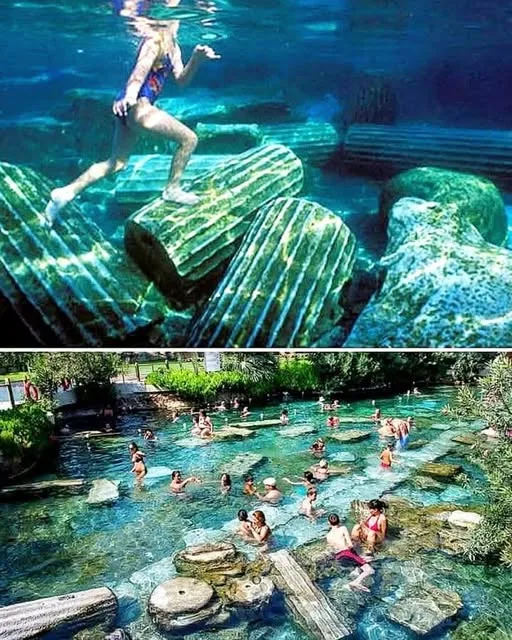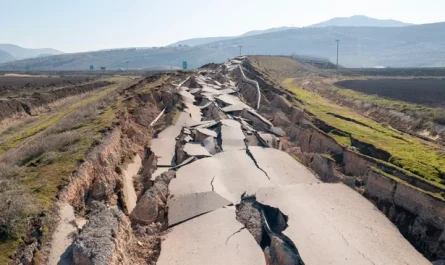The Cleopatra’s Pool, also known as the Ancient Pool of Hierapolis, is an extraordinary 2,200-year-old thermal marvel nestled within the historic ruins of Hierapolis in Pamukkale, Denizli, Turkey. Dating back to approximately 200 BCE, this natural wonder has long been celebrated for its healing properties and storied past, with legends claiming that Queen Cleopatra VII of Egypt herself graced its waters during her reign from 51 to 30 BCE. As of 10:57 AM +07 on Saturday, July 19, 2025, this iconic site continues to enchant visitors with its blend of natural beauty, archaeological significance, and therapeutic allure, drawing travelers from around the globe to step back in time.

A Historical and Legendary Oasis
Situated in the ancient city of Hierapolis, founded around the 2nd century BCE by the Pergamon Kingdom and later flourishing under Roman rule, Cleopatra’s Pool is part of a UNESCO World Heritage Site that encompasses the stunning travertine terraces of Pamukkale. The city earned its reputation as a premier spa destination due to its geothermal springs, which were believed to possess medicinal qualities. The pool’s association with Cleopatra stems from historical accounts suggesting she visited during her alliance with Mark Antony, seeking the mineral-rich waters to maintain her renowned beauty and health. While definitive proof remains elusive, this legend has woven a rich tapestry of intrigue around the site. The surrounding landscape, with its cascading white calcium carbonate formations shaped by millennia of mineral deposits, enhances the pool’s mystical aura, making it a natural and cultural landmark of unparalleled significance.
The Healing Waters and Unique Setting
Cleopatra’s Pool is fed by natural hot springs emerging from deep within the Earth’s crust, maintaining a consistent temperature of 36–38°C (97–100°F) throughout the year. These geothermal waters are laden with calcium bicarbonate, magnesium, and other trace minerals, which are reputed to alleviate a range of ailments, including rheumatism, arthritis, skin conditions, and even stress-related disorders. The pool’s crystal-clear waters, tinged with a soft turquoise hue due to the dissolved minerals, create a tranquil and inviting atmosphere. What sets this experience apart is the pool’s floor, where an earthquake in the 7th century toppled a Roman bathhouse, scattering its marble columns, capitals, and fragments into the water. Swimming among these ancient relics—some standing upright, others partially submerged—offers a rare and immersive connection to the past, blending relaxation with historical exploration. The gentle bubbling of the springs and the soft lap of water against the ruins add to the sensory richness of the experience.
Architectural and Cultural Significance
The pool’s evolution reflects both natural forces and human ingenuity. Originally part of a grand Roman bath complex, it served as a social and therapeutic hub for Hierapolis’ elite and visitors. The 7th-century earthquake, a common occurrence in this seismically active region, transformed the site by collapsing the bathhouse into the pool, where its remnants have since become an integral part of its identity. The surrounding archaeological landscape includes the well-preserved Roman Theatre, capable of seating 12,000 spectators, the Temple of Apollo with its sacred spring, and an extensive necropolis with over 1,200 tombs, illustrating Hierapolis’ role as a thriving Greco-Roman city. The pool itself was a centerpiece of the city’s spa culture, where rituals of cleansing and healing were intertwined with daily life. Its inclusion in the Hierapolis-Pamukkale UNESCO designation in 1988 highlights its dual importance as a natural phenomenon and a cultural treasure.
Visitor Experience: A Journey Through Time
As of 10:57 AM +07 on July 19, 2025, Cleopatra’s Pool offers a unique opportunity to immerse oneself in its warm, mineral-laden waters amidst a historical setting. The early morning hour provides a serene ambiance, with the golden sunlight casting long shadows over the ruins and illuminating the travertine terraces beyond. The pool is divided into managed swimming areas, with depths ranging from shallow wading zones to deeper sections where the ancient columns rise like silent sentinels. Lifeguards and staff ensure safety, while the gentle warmth of the water invites relaxation. The surrounding terraces, a UNESCO-protected natural wonder, glow brilliantly under the morning light, their stepped pools formed by centuries of mineral deposition from the springs. Visitors often describe the experience as otherworldly, with the combination of historical immersion and natural beauty creating a profound sense of timelessness.
Practical Tips and Modern Relevance
For a visit at 10:57 AM +07 today, preparation is key. Swimmers should bring a swimsuit, water shoes to navigate the slippery marble fragments, and a towel, as the pool’s bottom can be uneven. The site operates from 8:00 AM to 7:00 PM, with an entry fee that supports maintenance and conservation. Changing rooms, lockers, and a small café are available onsite, enhancing comfort. Early morning visits, like now, are recommended to avoid the midday heat and larger crowds, though the pool’s warmth remains consistent. Modern efforts emphasize sustainable tourism, with strict regulations to protect the travertine formations and water quality. The site also hosts educational programs and cultural events, reinforcing its role as a living heritage site that bridges ancient practices with contemporary appreciation.
Environmental and Geological Context
The pool’s existence is a direct result of the region’s tectonic activity, where fault lines allow hot water from deep underground to surface. This geothermal activity, combined with the high mineral content of the water, has shaped both the pool and the iconic Pamukkale terraces. The constant flow of water prevents stagnation, maintaining its clarity and therapeutic properties, while the earthquake-damaged ruins add a layer of geological history. Conservationists monitor the site to ensure that human activity does not disrupt this delicate balance, preserving it for future generations.
Conclusion
Cleopatra’s Pool is a mesmerizing fusion of nature and history, its warm, mineral-rich waters and sunken ruins offering a rejuvenating dive into the past. Linked to the legendary Cleopatra and framed by Pamukkale’s travertine wonders, it stands as a testament to ancient ingenuity and natural beauty. As you soak in its embrace at 10:57 AM +07 on July 19, 2025, it invites a deep appreciation for the enduring legacy of Hierapolis and the healing traditions that continue to thrive.




